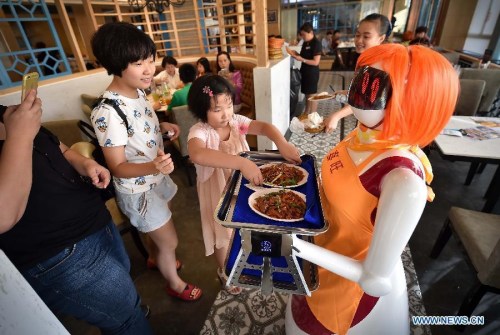
A girl takes dishes delivered by the robot waiter in Haikou, capital of south China's Hainan Province, Aug. 3, 2015. A robot waiter was introduced to a restaurant in Haikou. (Photo: Xinhua/Guo Cheng)
A restaurant serving Japanese ramen made by robots will make its debut in downtown Shanghai on Christmas eve, joining the trend of smart tech in service that swept across China this year.
The two ramen robots have a clear division of labor, working in tandem to pour noodles into the pot, boil them, add soup and ingredients, and serving. They are capable of finishing the whole process in an average of 90 seconds.
The robots can manage the boiling time precisely and control the amount of ingredients, keeping the taste and temperature consistent.
Apart from seafood and fried fish ramen, the robots can be upgraded to serve ramen with beef and braised pork in brown sauce to cater to Chinese customers' tastes.
In 2015 alone, dozens of restaurants featuring robots emerged in large and medium-sized cities across China. In addition to attracting curious customers, they have proven to increase efficiency and lower the operating costs.
As the first restaurant providing robot service in Changsha, capital of central China's Hunan Province, Moli Robot restaurant employed one greeting robot, two noodle-slicing robots and four serving robots when it opened in July.
Employing the robots is actually cost-effective, Moli's manager, surnamed Zhou, said.
Each robot cost around 48,000 yuan (about 7,400 U.S. dollars) -- about the same as the annual salary for one server. This means the restaurant can recover costs within a year, Zhou said.
"Normally one robot can work three to five years, so they are definitely much cheaper than employing waiters and waitresses," he said.
Burdened by rising salaries and a labor shortage, restaurant managers have had difficulties finding staff in recent years. Zhou said the serving robots have come at the right time as they are capable of addressing both issues.
Based on a report published by China's recruiting website Ganji, nearly 70 percent of enterprises in China are in shortage of labor this year, with enterprises lacking 14 employees on average. While in the service industry, each enterprise short of 16 employees.
The robots don't ask for leave and they won't get ill. Charge them for 6 hours during the night and they can work around 10 hours a day, said a woman surnamed Wu, who manages Shenghuayuan in east China's Hangzhou City.
Since customers are pleased to take photos and share them on social media after being served by the robots, "the robots become natural advertisements," said Wu.
China will focus on service robots and intelligent robots in the coming five years, according to Xin Guobin, vice minister of the Ministry of Industry and Information Technology at a meeting earlier this month.
In the coming 30 years, China will be the largest market of robots and intelligent equipment. By 2020, the number of robots in China will exceed 400,000, estimated by Luo Jun, secretary of the International Robotics and Intelligent Equipment Industry Alliance.


















































